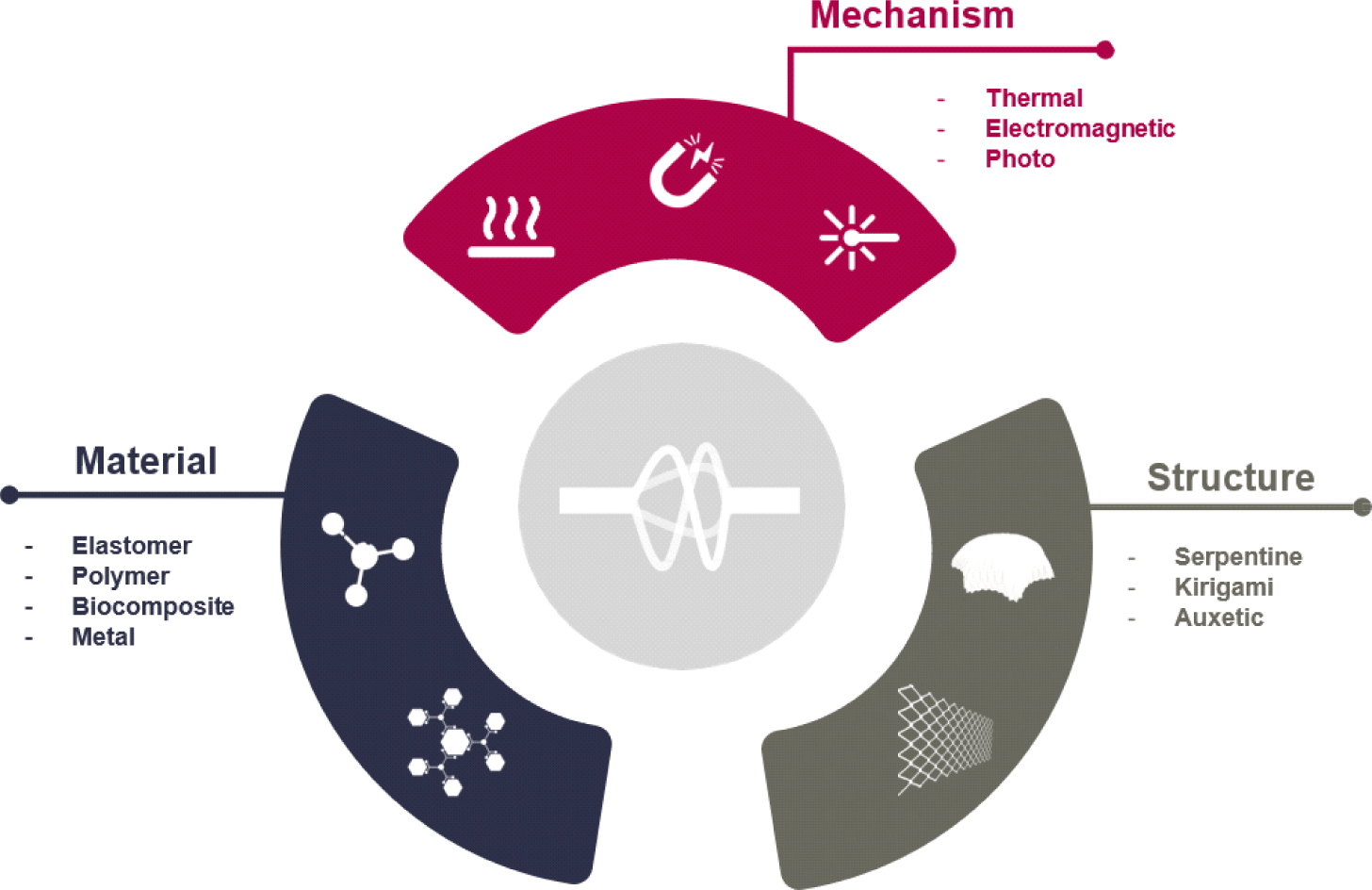1. INTRODUCTION
Programmable surface systems are reshaping the landscape of soft electronics by enabling active and reversible control over surface geometry and function in response to external stimuli. Unlike static materials, these systems are capable of undergoing dynamic, on-demand shape transformations, providing surfaces with enhanced adaptability and responsiveness. Their inherent advantages-such as lightweight construction, mechanical flexibility, and the ability to achieve multi-degree-of-freedom motion-make them highly suitable for a broad range of applications. These include biomimetic interfaces, medical devices, and soft robotic systems, where real-time reconfigurability and conformability to complex environments are crucial [1-3].
At the core of programmable surface behavior lies the careful selection of materials whose intrinsic responsiveness determines the overall system performance. Stimuli-responsive materials, including hydrogels [8], liquid crystal elastomers [3,4], biocomposites [9,10], and metals [11-13] enable reversible transformations through physicochemical changes such as swelling, softening, or phase transitions. The material’s responsiveness affects not only how deformation occurs but also how reliably and repeatedly it can be executed. As such, material choice directly influences deformability, reconfigurability, and longterm reliability, making it a foundational element in the design of programmable surfaces.
To better understand and design programmable surface systems, materials can be further classified by the type of external stimulus that drives their actuation. These include thermal [19], electrical [20], optical [25-27], and magnetic stimuli [21,22], each offering distinct modes of interaction and control. A stimulus-based classification provides a useful framework for analyzing how different materials convert energy into motion, and it also informs decisions on integration methods, spatial resolution, and energy efficiency. By identifying the mechanisms by which these stimuli interact with materials, researchers can tailor systems for specific functions and environments, from remote actuation to high-speed deformation.
Beyond material responsiveness and actuation input, the geometric structure of programmable devices plays a crucial role in shaping their mechanical behavior. Structural motifs such as serpentine [33], kirigami [34,35], and auxetic [37] architectures are widely employed to enhance stretchability and mechanical resilience. These designs allow surfaces to endure large deformations while maintaining functional stability and uniform stress distribution. Moreover, geometry-driven strategies provide an additional layer of programmability, enabling precise spatial control over deformation without compromising electrical or mechanical performance. As a result, structural design serves as a vital dimension in the creation of programmable surfaces that are both robust and reconfigurable.
To provide a comprehensive understanding of programmable surface systems, this review categorizes recent research across three fundamental dimensions: materials, mechanisms, and structures. Programmable materials are broadly classified into elastomers, polymers and metals. Actuation mechanisms are organized into thermal, electromagnetic, and photo-induced categories. Finally, structural design strategies are examined through the lens of serpentine, kirigami, and auxetic architecture. This framework offers insights into the key design principles guiding current research and lays the foundation for developing next-generation programmable soft systems.
2. PROGRAMMABLE SYSTEMS
Elastomers are materials that can quickly recover their shape after the applied stress is removed and are self-recovering materials that can be explained by changes in conformational entropy [4]. Stimuli-responsive elastomers utilize reversible changes in their physical and chemical properties in response to external stimuli such as temperature, light, electric fields, or magnetic fields.
Polyethylene glycol (PEG) is a polymer primarily used in cosmetics and food products. It functions as a viscosity regulator or, when the number of oxyethylene groups increases, as a moisturizing agent in polymer form. Polyurethane (PU) is a thermosetting resin with the advantage of excellent elasticity.
Muff et al. proposed a semi-crystalline polyurethane bilayer actuator combining a soft segment of PEG with a rigid segment from an HDI/BDO reaction. The crystallization of PEG at the crystal-melt transition achieves large nonlinear thermal expansion properties, and the shape is maintained by the physical crosslinking of the rigid segment. Bilayers fabricated by compression molding can induce large deformations at high refractive indices and low transition temperatures (~65 ? or less) by using Joule heating, especially electrothermal control methods. However, due to the highly hygroscopic nature of PEG, it absorbs water and expands upon humidity increase, resulting in curvature relaxation, so humidity management and BDO sum control must control the balance between CLTE/strain and reproducibility. This shows promise for a variety of applications, including drug delivery systems, biomedical devices, soft robots, etc [Fig. 1(a)].

Liquid crystal elastomer (LCE) is a stimulusresponsive material that simultaneously possesses the properties of fluid liquid and an elastic rubber and is primarily manufactured by crosslinking liquid crystal mesogens into a highly deformable elastomer network [6].
Guo et al. conducted research using 4-methoxybenzoic acid and acryloxy-based structural compounds to provide large reversible deformation and recently used independent cubic voxels to assemble complex 3D shapes. Each voxel has a specific directional director field and achieves anisotropic and heterogeneous deformation through thermal and optical stimuli. This overcomes the limitations of existing technologies, which were restricted to 2D to 3D deformation, enabling the realization of various geometric shapes. The LCE-based voxel assembly method uses UV adhesive to bond the voxels, and since these joints may have a subtle influence on shape changes, long-term durability evaluation is necessary. From the perspective of flexible electronic devices, future research should focus on integrating sensors and electronic circuits into LCE, as well as analyzing subtle fluid dynamic phenomena at the joints between voxels and studying the thermal-fluid-structural interactions during shape deformation [Fig. 1(b)].
Dielectric elastic materials (DEA) are materials that undergo large deformations under an electric field.
Hajiesmaili et al. reported research on achieving precise shape changes by spatially varying the electrode array. The material was manufactured using a centrifugal mixer with an acrylic based precursor, urethane acrylate oligomer, viscosity modifiers, strength enhancers, and controllable crosslinkers and photoinitiators. Subsequently, spin coating was performed to implement flexible electrodes using carbon nanotubes. This method enables precise control of Gaussian curvature by utilizing the multilayer structure and mesoarchitecture of the internal electrodes. This allows for the free implementation of positive and negative curvatures and provides reversibility, returning to its original form when the voltage is removed. However, this method faces practical challenges due to high voltage requirements and a complex manufacturing process. Therefore, the development of materials and bonding technologies that maintain stable electrical properties and durability even after repeated deformation is necessary for application in flexible electronic devices [Fig. 1(c)].
Polymers are materials that contain physicalchemical conjugated or non-conjugated bonds and exhibit diverse properties through various cross-linking mechanisms. Elastomers are a type of polymer with low crystallinity due to weak cross-linking. In this section, we focus on stimuli-responsive polymers rather than elastomers [9].
Shucong Li et al. have developed a programmable surface based on liquid crystal polymers (LCPs), a technology that exploits mechanical softening due to solvent absorption and geometry rearrangement upon evaporation to enable microstructure control via capillary forces. Unlike LCE, LCP is a material with high strength and alignment due to the liquid crystal mesogen groups linked to the scaffold. The process of softening, evaporation, and curing can be precisely controlled by adjusting the mixing ratio of the liquids. This technology has a wide range of functional applications, including information encryption, particle trapping, and bubble release. However, challenges remain in maintaining uniformity of structural deformation during the liquid evaporation process and ensuring long-term material stability, which depends on the chemical composition of the liquid [Fig. 2(a)].
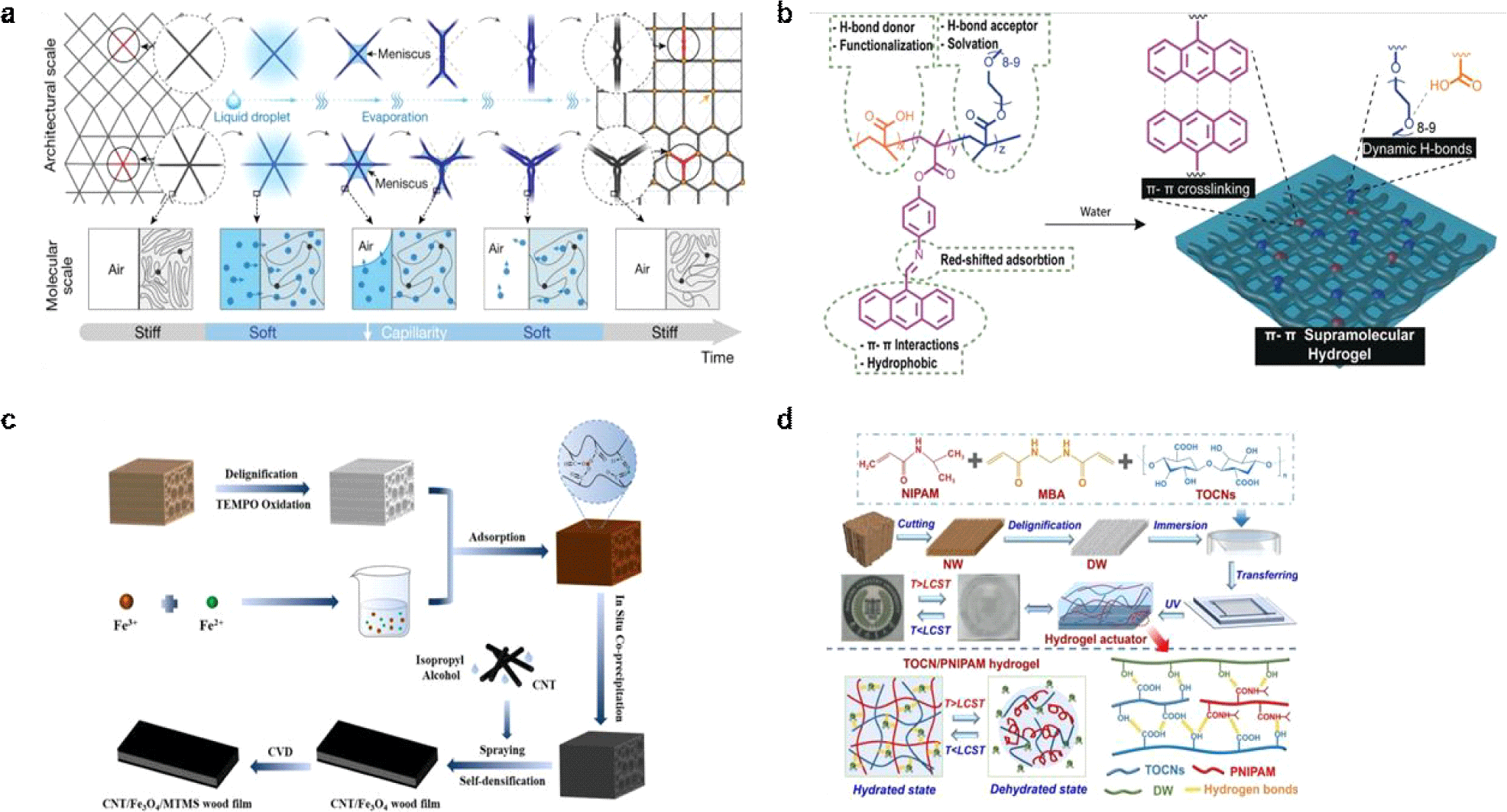
Hydrogels are polymers with a three-dimensional cross-linked structure that retains moisture due to their hygroscopicity.
Jiang et al. developed a high-strength, self-healing, and recyclable actuator that responds to visible light. By using benzylamine-functionalized anthracene groups, they enabled absorption in the visible light spectrum and achieved high mechanical strength and rapid self-healing properties through a supramolecular network utilizing p-p interactions and hydrogen bonds. This hydrogel exhibits rapid shape transformation in both wet and dry environments and is reprogrammable, enabling reconfiguration into various three-dimensional shapes [Fig. 2(b)].
Chen et al. studied bio-composite materials, primarily wood-based superhydrophobic photodriven films and nanocellulose and wood-bonded hydrogels. The wood film-based actuator utilizes Fe?O?, CNT, and MTMS to achieve excellent mechanical strength, superhydrophobicity, and photothermal conversion performance. In particular, the introduction of Fe?O? significantly enhances the photothermal conversion effect, enabling stable and rapid linear motion under NIR light irradiation [Fig. 2 (c)].
Lu et al. combined an anisotropic wood structure with a temperature-sensitive hydrogel to achieve high mechanical strength and rapid thermal responsiveness in a nanocellulose-based actuator. This enabled programmable deformation and information encryption applications. However, managing moisture content changes due to ion concentration and temperature variations, as well as fatigue phenomena during repeated deformation, remain as future research challenges [Fig. 2 (d)].
Stimuli-responsive metals, such as Ni-Ti (nitinol), which belong to the category of shape memory alloys (SMA), can primarily respond to heat through phase transitions between the austenite phase and the martensite phase. However, these responses are often irreversible or difficult to control [14]. Furthermore, liquid metals or solid metals can be controlled using their electromagnetic properties, such as magnetism and current [15,16].
Zhang et al. developed an MME core-cover fiber based on liquid metal, using a polymer composite containing magnetic particles as the outer coating. The focus is on liquid metals such as gallium-indium (EGaIn). This liquid metal core provides high electrical conductivity (approximately 2.07×106 S/m) and excellent mechanical flexibility, enabling continuous deformation without damage. Through coaxial printing processes, it enables the realization of delicate 2D and 3D structures, integrating programmable magnetization, magnetic actuation, and sensing functions, making it a material suitable for various applications such as minimally invasive electrical surgery and remote energy transmission in soft robots and biomedical devices. The printing process itself has limitations in terms of high-precision patterning at the micro scale, and there is room for improvement in the adhesion between liquid metal and composite material interfaces [Fig. 3(a)].

Zhang et al. manufactured a solid metal-based 3D mesostructure that includes conductive metal layers such as copper (Cu) and nickel (Ni). This structure possesses structural stability due to its polyimide (PI) coating. Utilizing electromagnetic forces, this structure enables rapid and precise deformation through the Lorentz force and magnetic force. Specifically, deformation can be precisely controlled based on the thickness and arrangement of the metal layers within the structure, and programmable structural forms can be realized through transitions to multiple stable states. These characteristics enable applications such as thermal conductivity measurement and multimode sensors; however, there is a possibility of issues arising from heat generation caused by currents generated alongside the Lorentz force, necessitating analysis of heat transfer during electromagnetic operation [Fig. 3(b)].
In this section, we classify and examine programmable mechanisms based on the type of external input, specifically focusing on three representative categories: thermal, electromagnetic, and photo-induced actuation.
Thermal actuators operate by absorbing heat and converting the resulting temperature change into mechanical deformation. The thermal energy required for actuation can originate from various sources. Actuation is most commonly driven by either electrical input (electrothermal actuation) or light exposure (photothermal actuation), depending on the system’s design and energy delivery strategy [17,18]. Regardless of the heat source, the fundamental mechanism involves localized heating that induces internal stress or softening, enabling the surface to change its shape in a controlled and reversible manner.
Babakhanova et al. demonstrated a thermally responsive programmable surface using liquid crystal elastomers (LCEs). By employing photoalignment techniques, they inscribed precise molecular orientation patterns into the LCE, enabling the surface to deform into concave or con-vex shapes in response to temperature changes. Specifically, radial (splay) alignment induced depressions, while circular (bend) alignment produced elevations, both driven by an “activation force” arising from spatial variations in molecular orientation [Fig. 4(a)].
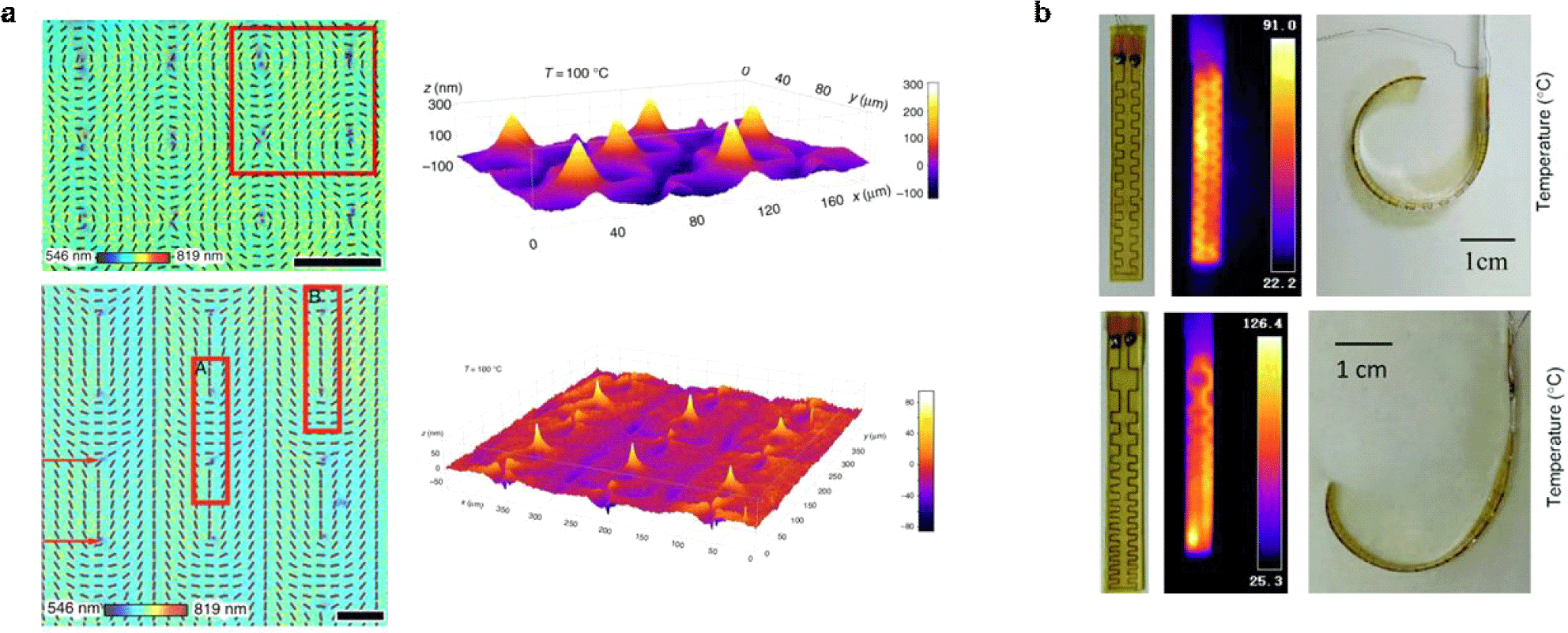
Cao and Dong developed a soft electrothermal actuator capable of complex programmable surface deformations by leveraging the free-form design of embedded heaters. Using electrohydrodynamic (EHD) printing, they directly patterned low-melting-point Bi/Sn alloy heaters within a PDMS/PI bilayer structure. This approach enabled precise spatial control of heat distribution, allowing deformation modes such as uniform bending, graded bending, localized folding, and twisting depending on the heater geometry. By varying line spacing, orientation, and location of the printed heaters, they achieved diverse and reconfigurable 3D shape changes. This method surpasses traditional uniform heating-based actuators and offers a versatile platform for soft robotics and adaptive structures through shape programmability at the surface level [Fig. 4(b)].
Electromagnetic actuators utilize the Lorentz force to achieve programmable deformation in soft surface systems. By embedding conductive liquid metal ribbons within an elastomeric matrix and applying a static magnetic field, localized currents can be precisely controlled to generate distributed Lorentz forces. This configuration enables rapid and reversible shape morphing with low power consumption, as demonstrated in recent studies.
Bai et al. developed a dynamically reprogrammable metasurface that enables high-speed, highprecision shape morphing through Lorentz-forcedriven actuation. The system consists of a serpentine goldpolyimide conductive mesh embedded in a soft substrate, where programmable electrical currents interact with an external magnetic field to induce localized out-of-plane deformations. By varying the current distribution via independent voltage control, the surface can morph into diverse 3D shapes within 0.1 seconds.
A key innovation lies in the hybrid control scheme: a model-driven inverse design enables rapid approximation, while a feedback-based experimental loop using real-time 3D stereo imaging corrects for nonlinearity and environmental perturbations. This approach allows the surface to self-evolve into target shapes and even achieve multifunctionality, such as simultaneous optical alignment and structural displacement. The platform demonstrates a data-driven strategy for programmable soft matter with potential applications in soft robotics, adaptive optics, and intelligent surfaces [Fig. 5(a), Fig. 5(b)].
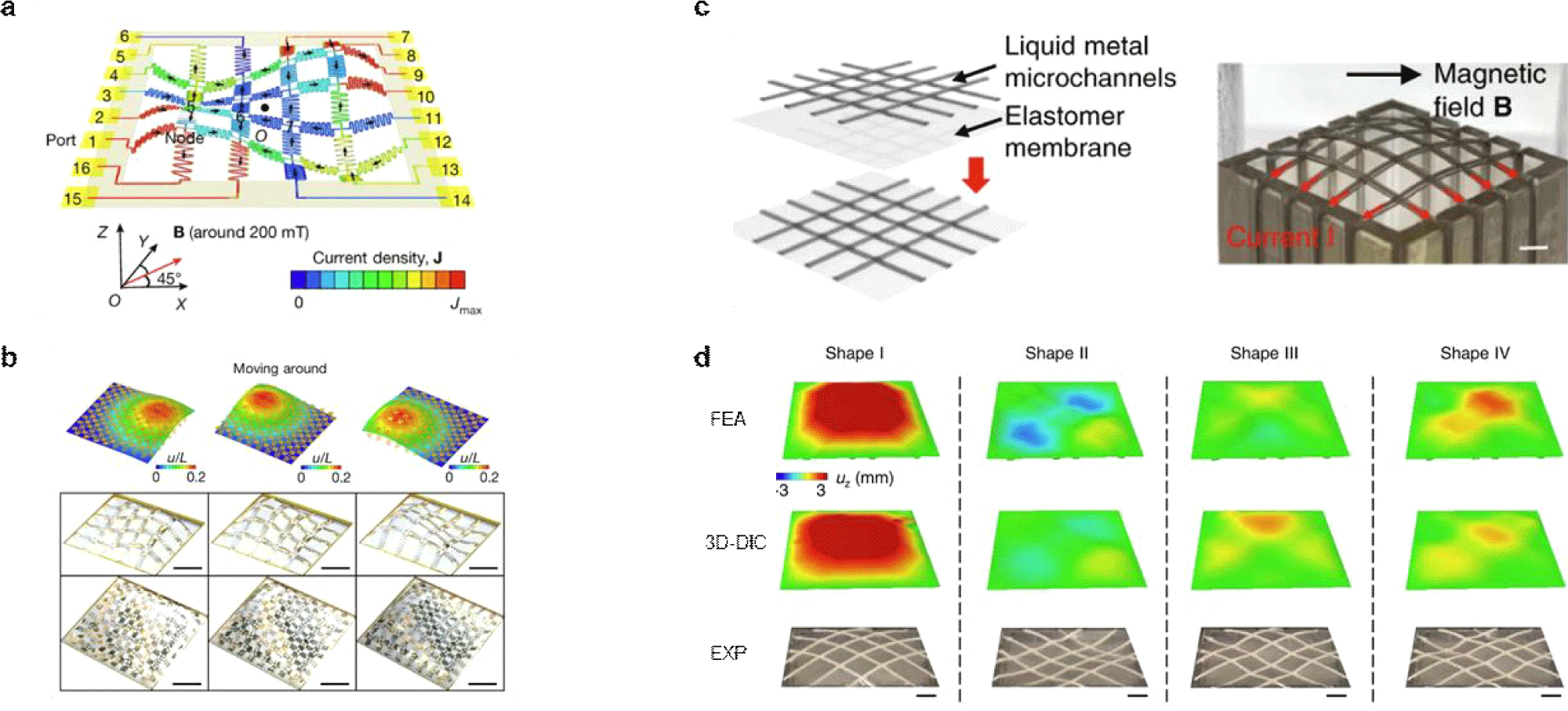
Ni et al. introduced a soft, shape-programmable surface that integrates liquid metal microfluidic networks into an elastomer membrane, enabling rapid and reversible 3D morphing under electromagnetic actuation. By injecting currents into crossbar arrays of liquid metal ribbons placed in a magnetic field, Lorentz forces induce localized deformations with sub-second response time. A key innovation lies in the use of 3D digital image correlation (3D-DIC) to build a large database that maps surface deformations to specific current distributions, allowing for near-instant retrieval (within milliseconds) of actuation patterns for desired target shapes-significantly faster than finite element analysis (FEA). Furthermore, by solidifying the liquid metal, the system can fix shapes without continuous power and reprogram them upon reheating [Fig. 5(c), Fig. 5(d)].
Light enables contactless and spatially targeted actuation, offering distinct advantages over conventional electrical stimulation [23,24].
Ford et al. developed photoresponsive soft actuators by integrating gold nanorods (AuNRs) into liquid crystal elastomer (LCE) matrices, enabling localized photothermal actuation under near-infrared light. Using direct ink writing (DIW), complex 3D architectures were printed with shear-aligned mesogens, allowing precise control over deformation in response to light. The AuNRs generate localized heating, triggering nematic-to-isotropic transitions that result in various programmable shape changes such as bending, crawling, rolling, and lifting. By combining structural design, controlled printing, and selective optical stimulation, the actuators demonstrated multiple modes of motion and even physically intelligent behaviors like damage avoidance. The inclusion of computer vision-based laser tracking further enabled closed-loop control of rolling motion, highlighting a powerful strategy for constructing next-generation soft machines using light as both a power source and controller [Fig. 6(a)].
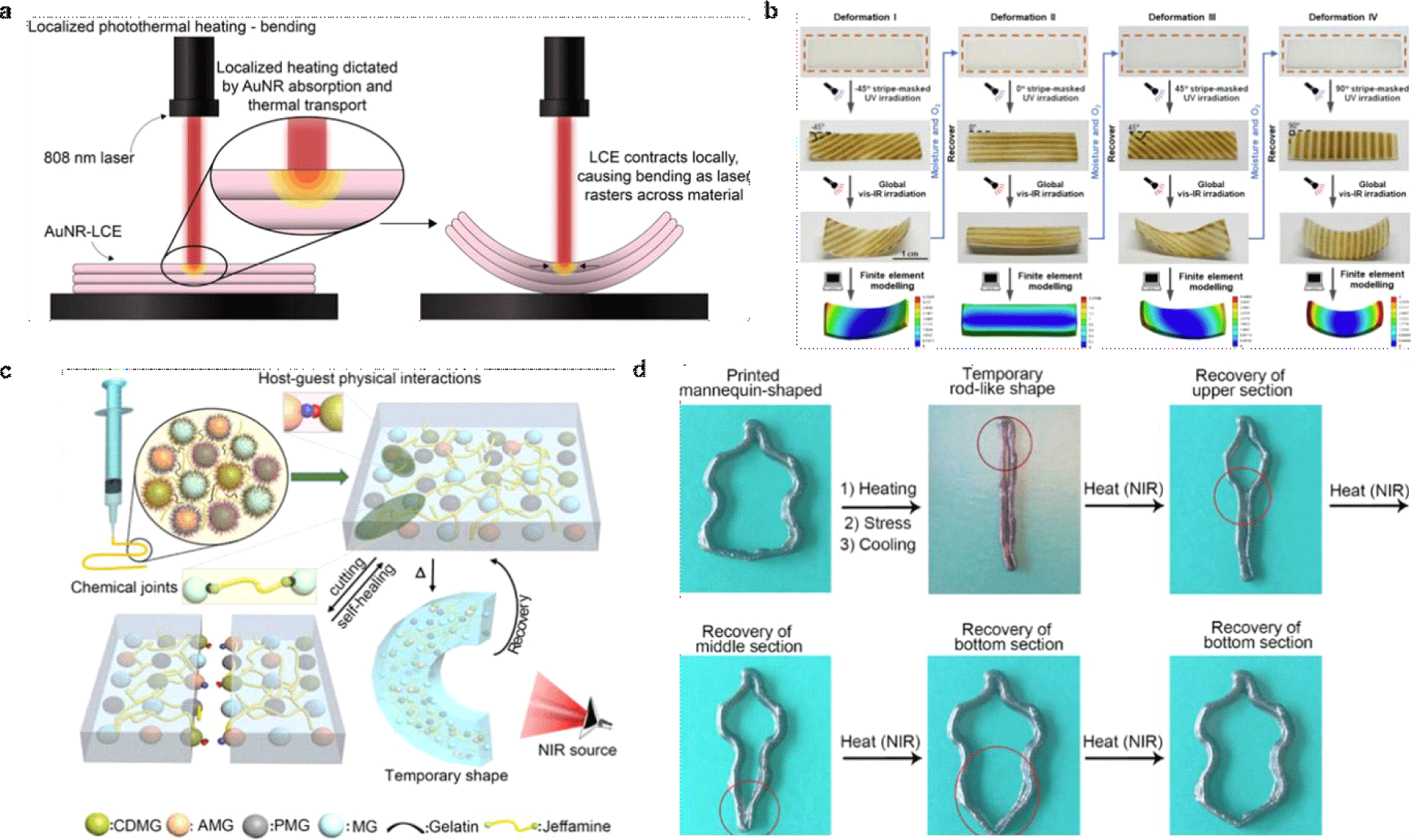
Peng et al. developed a reprogrammable shapemorphing hydrogel system by synergistically integrating photochromism and photothermal actuation using surface-functionalized CdS quantum dots. Upon UV irradiation, the CdS QDs undergo a reversible color change from white to black, modulating their photothermal conversion efficiency under subsequent vis-IR exposure. This enables programmable, stressfree deformation of 3D-printed bilayer hydrogels through light-controlled internal water loss gradients. The deformation direction and magnitude can be precisely tuned by designing UV-induced stripe patterns at specific angles. Beyond simple morphing, the system supports dual-mode 3D/4D shape memory, and polydopamine-modified microgels for efficient photothermal conversion under NIR light. These components were extruded via extrusion printing and chemically crosslinked post-printing to form a robust, shape-memory network. The actuator operated through segmental NIR-induced heating: localized laser irradiation triggered polydopamine-based heating, softening the hydrogel and recovering the pre-programmed permanent shape without affecting adjacent regions. This modular material strategy enabled programmable, spatially selective actuation with reusability and self-healing, making it a powerful platform for advanced soft robotics [Fig. 6(b)].
Sheikhi et al. developed a 4D-printed soft actuator based on multifunctional granular hydrogels, engineered by combining four types of microgels with distinct roles. The actuator ink incorporated β-cyclodextrin and adamantylamine-functionalized microgels to enable host-guest interactions for self-healing and shear-thinning behavior, epoxy-bearing microgels for covalent crosslinking with Jeffamine to achieve thermal information encryption, light-guided object manipulation, and even logic gate control in soft electronics. This approach introduces a novel material-level mechanism for light-driven soft actuators, enabling on-demand, reversible, and spatially selective reconfiguration without mechanical reprogramming [Fig. 6(c), Fig. 6(d)].
A growing number of researchers have aimed to develop fully stretchable electronic systems to meet the demands of next-generation wearable devices [28]. To achieve this, significant efforts have been directed toward imparting stretchability not only to individual components but to the entire integrated system.
One of the most effective strategies has been the use of geometrically engineered structures, which enable materials with inherently low stretchability to withstand large deformations. In particular, these structural designs have been instrumental in enhancing tolerance to tensile strain in the horizontal direction, thereby expanding the mechanical limits of soft electronic devices.
In this section, programmable structures are classified into three representative geometric strategies-serpentine, kirigami, and auxetic designs.
Serpentine interconnects, particularly those with noncoplanar geometries in either their fabricated or deformed states, offer enhanced stretchability and mechanical adaptability. Their deformation behavior is well understood through experimental and theoretical studies. When fabricated in ultra-thin forms and integrated with soft elastomeric substrates like PDMS or Ecoflex, these structures achieve effective moduli comparable to human skin (~100 kPa), enabling conformal integration for wearable applications [29,30].
Zhang et al. conducted a systematic study on the mechanical behavior of serpentine interconnects in elastomer-supported stretchable electronics, emphasizing their ability to achieve both high stretchability and areal coverage. Through a combination of analytical modeling, finite element simulations, and experiments, they identified critical buckling modes-symmetric and anti-symmetric-and derived scaling laws that predict elastic and total stretchability based on geometric parameters such as length-to-spacing ratio, unit cell number, and cross-sectional dimensions. Their optimized serpentine design achieved up to 172% total stretchability and 81% areal coverage, while maintaining electrical performance under extreme deformation, demonstrating serpentine geometry as a key strategy for highly deformable and mechanically programmable soft electronic systems [Fig. 7(a)].
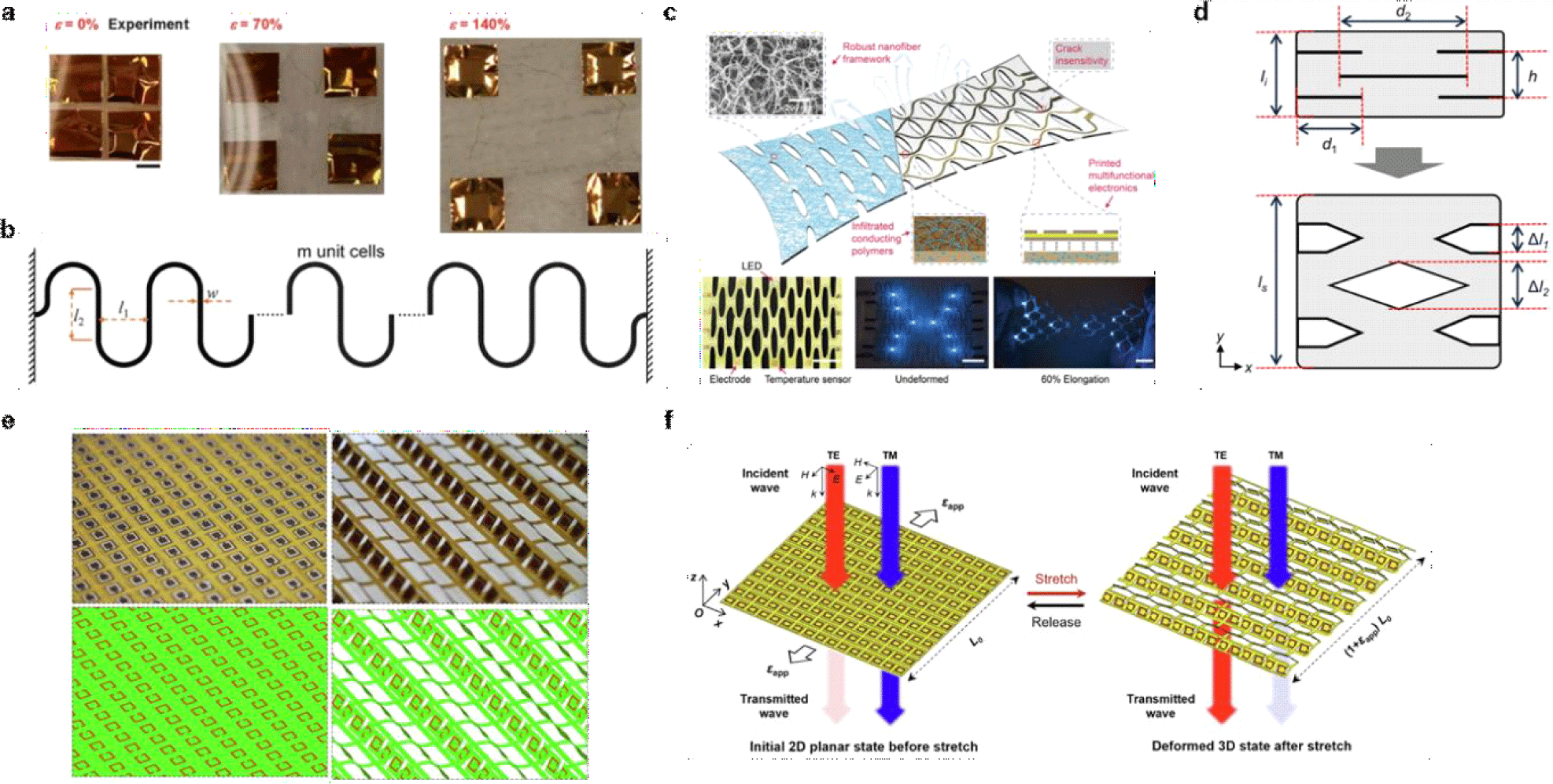
Kirigami-inspired structures, formed by strategically introducing patterned cuts into solid membranes, facilitate large deformations in stretchable electronics through bending and twisting motions. Their high stretchability and ability to conform to complex 3D surfaces make them particularly well-suited for wearable human-machine interfaces [31,32].
Liu et al. developed a kirigami-based soft electronic platform by integrating a tough, porous composite nanofiber framework (CNFF) composed of aramid nanofibers and polyvinyl alcohol, designed for conformal and stretchable skin mounted devices. The CNFF substrate, fabricated via blade coating and critical point drying, offers high toughness and breathability, making it ideal for wearable applications. Electronic functionality was introduced using two complementary strategies: microfabricated inorganic circuits were transfer-printed onto the CNFF for highperformance sensing, while conducting polymers such as PEDOT were electrochemically deposited within the porous network to form stretchable interconnects. Laser-cut kirigami patterns imparted exceptional mechanical deformability, enabling devices to stretch over 130% strain and endure over 5,000 cycles without electrical failure. These devices conformed seamlessly to dynamic 3D skin surfaces and maintained stable electrical outputs for physiological sensing, including ECG, EMG, and skin temperature. This fabrication approach demonstrates a robust and scalable path for multifunctional, breathable, and stretchable bioelectronics [Fig. 7(b)].
He et al. developed a mechanically reconfigurable soft metasurface by integrating kirigami design with copper split-ring resonators (SRRs) patterned on a thin polyimide (PI) substrate. By introducing strategically placed laser-cut slits, the initially planar metasurface transforms into a three-dimensional configuration when uniaxial strain is applied, causing the SRRs to rotate out of plane. This structural reconfiguration enables selective modulation of electromagnetic wave transmission, enhancing or suppressing the passage of linearly and circularly polarized waveswithout significantly shifting the resonant frequency. Notably, deformation relies solely on mechanical stretching, eliminating the need for active materials or external circuitry. This kirigami-based approach offers a lightweight, ultrathin, and tunable platform for adaptive electromagnetic devices, particularly suited for wearable RF systems, satellite communications, and deployable antennas [Fig. 7(c), Fig. 7(d)].
Auxetic structures, characterized by a negative Poisson’s ratio, expand laterally when stretched, offering unique mechanical properties such as enhanced energy absorption, shear resistance, and conformability. These attributes make them particularly suitable for applications in stretchable electronics and wearable devices. Recent studies have demonstrated the integration of auxetic geometries into various substrates to improve mechanical performance and functionality [36].
Loh et al. developed a 3D-printed soft electronic surface by integrating a capacitive sensing array into an auxetic mechanical metamaterial framework. The sensor array consists of 6×6 capacitive sensors embedded at the vertices of an auxetic lattice, which expands laterally under tensile strain due to its negative Poisson’s ratio. This unique geometry fabricated using multimaterial FDM 3D printing with carbon-loaded PI-ETPU electrodes and TPU dielectric layers, allows the sensor array to conform closely to curved and deforming surfaces without altering capacitance during stretching (up to 21.6% strain). As a result, the sensor accurately detects normal contact forces while remaining insensitive to geometric deformation, enabling decoupled sensing of force and strain. Demonstrations on soft robotic grippers showed real-time force mapping and object shape recognition, while wearables on human joints achieved personalized conformability and contact force detection (Fig. 8).
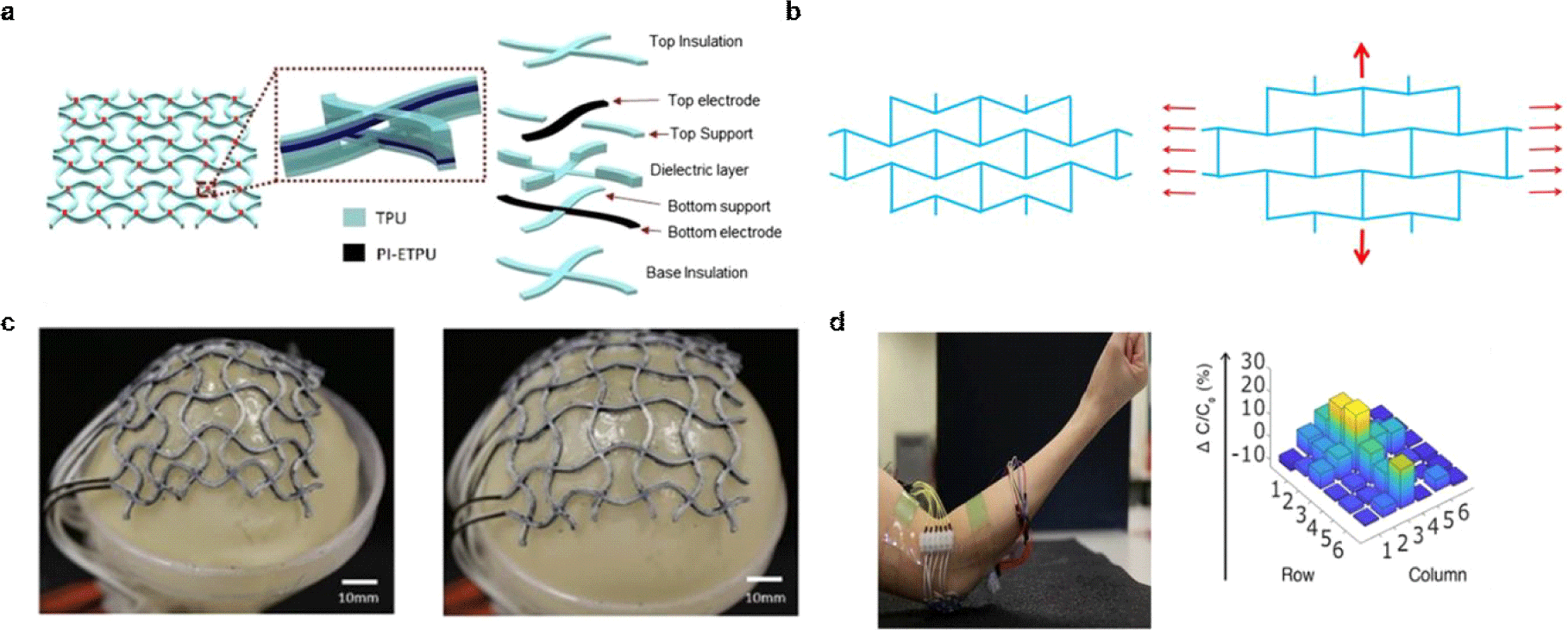
3. PERSPECTIVE AND FUTURE PROSPECTS
Programmable surface systems have shown remarkable progress in recent years, yet several challenges and opportunities remain for future exploration. To date, the application of these actuators has been largely confined to areas such as biomimetic interfaces, medical devices, and soft robotic systems. To fully realize their potential, future efforts should explore broader applications across diverse fields, expanding beyond the currently established domains.
Chen et al. demonstrated a wireless, ultra-thin, and ultra-light programmable surface based on electro-hydraulic actuation, designed as a haptic electronic skin for on-body applications. The system was fabricated using microcircuit printing and microfluidic injection techniques to create individual electro-hydraulic actuators, each consisting of a dielectric oil encapsulated between printed electrodes and elastic membranes. Upon applying high-voltage electric fields, Maxwell stress compresses the oil, causing localized surface protrusions that form programmable tactile patterns. The actuators, only 199 μm thick and 23 mg in weight, can be individually controlled to generate up to 150 mN of force and 0.58 mm of displacement. This programmable surface was integrated into wearable devices for various practical applications, including real-time Braille displays with 98% recognition accuracy, tactilebased navigation for visually impaired users, and immersive haptic feedback during gaming scenarios. The system exemplifies a scalable and functional approach to shape-morphing soft electronics for interactive human-machine interfaces (Fig. 9).

Kim et al. developed a gallium-based programmable surface to actively control and quantitatively analyze flow fields in real time through wind tunnel PIV experiments. Furthermore, they presented a dynamically reconfigurable surface using liquid metal-based soft microfluidics and electromagnetic actuation, enabling rapid 3D shape morphing from a flat 2D state. By synchronizing the surface deformation with projected content, the system allows applications such as adaptive projection screens with vibration cancellation and interactive 3D displays simulating physical interactions, supported by real-time 3D imaging and computational modeling (Fig. 10).

Given their ability to undergo flexible deformation, these systems hold promise for integration into a wider range of applications. Beyond skin-attachable haptic interfaces, they could be extended to domains such as fluid manipulation, thermal regulation, and structural adaptation.
Achieving such versatility will require overcoming key challenges, particularly in miniaturization and wireless operation. For broader applicability, it will be essential to develop programmable surface platforms that are both compact and lightweight while supporting wireless communication capabilities. This remains a significant challenge for the field moving forward.







